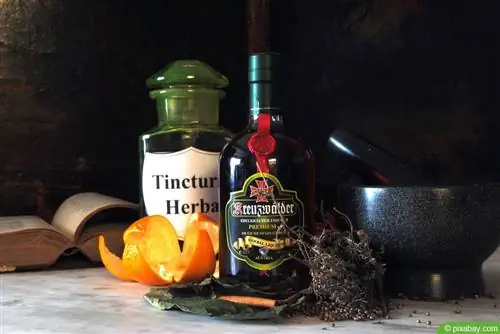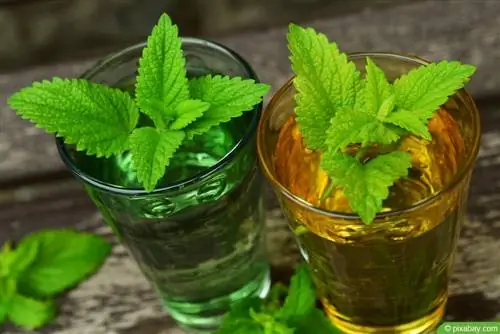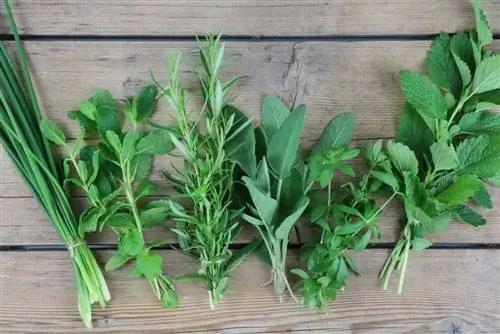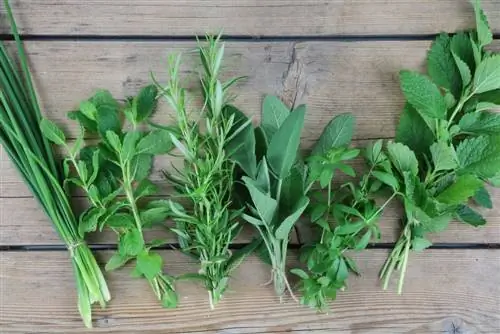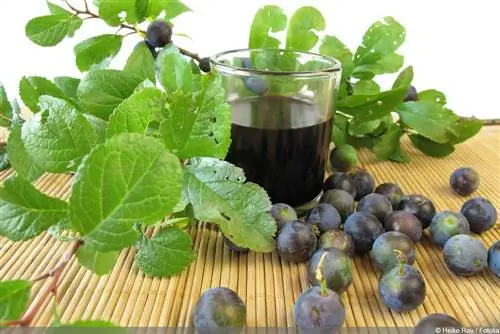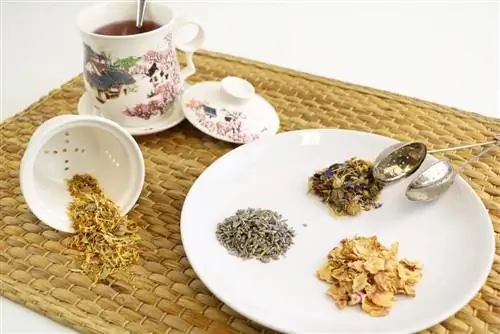- Author admin [email protected].
- Public 2023-12-17 03:39.
- Last modified 2025-01-24 12:45.
A colorful array of fresh or dried herbs, fruits, roots and spices is transformed into a superlative spiritual drink in high-proof alcohol. As herbal schnapps, nature's treasures unfold their full potential for well-being and enjoyment. Cult brands like Jägermeister and Ramazotti turn their recipe into a mystical secret. In reality, you can make herbal liqueur yourself without much effort. This collection of 5 recipes explains how you can make your own herbal schnapps in no time.
What you need to know about production
In Germany, Austria and Switzerland, spirits made from herbs have a centuries-long tradition. In the early Middle Ages, the legendary polymath Hildegard von Bingen proclaimed the healing effects of herbal liqueurs for stomach and digestive problems. A high proportion of bitter substances promotes the function of the stomach, bile and intestines, stimulates the production of digestive juices and relieves the feeling of fullness. To this day, herbal schnapps have lost none of their relevance. However, the primary use has shifted from healing power to enjoyment.
What is herbal schnapps
Under the heading herbal schnapps, a distinction is made between herbal bitters or stomach bitters with a bitter taste and at least 15 percent alcohol. By adding sugar, the spirit drink turns into a semi-sweet or liqueur and is a delicious palate tickler. Famous brands have made a significant contribution to modern cult status:
- Jägermeister
- Fernet Branca
- Runt
- Ramazotti.
Home gardeners with a penchant for self-sufficiency and their own herb bed can make herbal schnapps with a personal touch. A wide range of herbs, spices and exotic ingredients leaves plenty of scope for individual creations. From A, like anise, to Z, like cinnamon, there are no limits to the spicy, spirited arrangement. A tasteless, high-proof alcohol motivates the herbs to release their valuable ingredients. This process takes several weeks and is considered the biggest challenge in the uncomplicated production of fine herbal drops. Making herbal liqueur requires an epic amount of patience.
Traditional basic recipe
If the beneficial effect of a stomach bitter is the main focus, the focus is on the traditional recipe without the use of sugar. The motto that governs the preparation here is: “What is bitter in the mouth is he althy for the stomach. The ingredients come from our own herb garden or are collected in fields and forests. Local wild herbs such as dandelion, mugwort, yarrow and hops contain large amounts of bitter ingredients that support the liver, intestines and bile in their work. A glass of schnapps is enough to relieve painful flatulence or annoying feeling of fullness.
Ingredients for 1 liter of herbal bitters
- the leaves and roots of 5 dandelion plants (about 2 handfuls)
- 10 tbsp yarrow
- 5 tbsp wild hop flowers
- 5 tbsp mugwort
- 1000 ml 40 percent alcohol (optionally grain, schnapps, vodka)
Preparation
Dig up dandelions. Clean entire plants under running water. Cut off leaves and roots, pat dry and chop. Also chop the mugwort and yarrow into small pieces. Put the herbs in a sealable container and pour the alcohol over them. Shake several times so that the ingredients mix well. Let it steep at room temperature for two to four weeks. Then strain and fill into glass bottles.
Note: All recipes in this collection are used to make high-proof herbal schnapps for adults. The spirits, even in highly diluted form, are completely unsuitable for rebellious children's tummies. Always keep bitters out of the reach of children.
Savoury herbal liqueur
If sugar comes into play, stomach bitters transform into a tasty, sweet drink with a pleasant effect. The following recipe is based on valuable herbs and spices that help against stomach upset after a rich holiday feast or give refreshing long drinks a special kick.
Ingredients for 1 liter
- 2 handful of peppermint
- 3 cardamom pods
- 3 tbsp chamomile
- 1 tbsp cloves
- 1 tsp coriander seeds
- 1 tsp fennel seeds
- 1 cinnamon stick
- 100 g sugar
- 1 l 40 percent alcohol (grain, schnapps, vodka)
Preparation
Crush the peppermint leaves. Crush spices and seeds in a mortar. Pour the ingredients into a sealable container and mix. Pour the alcohol over it, close tightly and shake vigorously. Leave to steep in a dark place at room temperature for about 4 weeks. Then open the container, strain the liquid and fill it into bottles with screw caps.
Tip:
It is best to store the finished herbal schnapps in a dark, cool place. Although the filled bottles are a feast for the eyes, the quality of the high-proof contents suffers when exposed to light. When sun rays hit herbal liqueur, many aromatic substances are destroyed, which significantly affects the taste.
Grandma's herbal liqueur
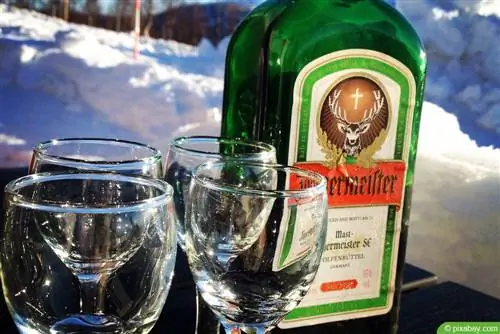
This recipe is intended for nature lovers who make their own herbal schnapps with a touch of Jägermeister. Local herbs form an aromatic combination with wine spirit as neutral alcohol, with the addition of sugar and water. These are the key data for the mysterious recipe according to which the descendants of the legendary company founder have been producing Jägermeister liqueur in Wolfenbüttel since 1934. The list of ingredients only contains 11 herbal plants instead of the 56 in the original recipe. Of course, there is nothing wrong with expanding at your own discretion.
Ingredients
- 275 ml pure alcohol (96 percent spirit)
- 525 ml water
- 75 g sugar
- 1 Organic Orange
- 150 g herb mix made from 11 different meadow herbs
- 10 g licorice root (from the pharmacy)
- 8 g calamus (from the pharmacy)
- 1 tsp anise seeds
- 1 tsp caraway
- 1 tsp fennel seeds
- 1 tsp lemon juice
Many local plants that thrive in the natural garden or are collected on the go can be used for the herb mix. These include brook mint, mugwort, blackberry leaves, field thyme, ground thyme, ground gunder, St. John's wort, marjoram, red clover, yarrow, chicory, fireweed and meadow sage.
Preparation
Wash organic orange and pat dry. Peel the peel very thinly with a vegetable peeler without leaving any white underside. Scald strips of peel with boiling water for 30 seconds, pour into a sieve and allow to drain. Fill the orange peel into a wide-mouthed bottle, pour the spirit over it and close it. Leave to steep in a warm, dark place for 5 days. Pour alcohol into a bowl. Discard leftover peel. Chop up the herbs, wash them and shake them dry in a sieve. Place in a bottle with the spices and pour orange peel alcohol over it. Close the bottle, shake and leave to infuse in a warm, dark place for 4 weeks.
Shake vigorously once a day
After 25 to 30 days, strain the extract using a filter bag. Herbs and spices linger in the bottle. Bring the water, sugar and lemon juice to the boil in the saucepan while stirring and simmer for 5 minutes. Pour hot over the herbs and spices. After cooling, strain the syrup from the bottle through a coffee filter bag. Mix the herb-spice extract and syrup, pour into a glass bottle and let it steep in a dark, cool place for 4 weeks. Then filter the liqueur again and let it rest for another 3 to 6 months.
Mediterranean recipe
If basil, sage, rosemary and marjoram thrive in the bed and on the balcony, you can use this as a basis to make your own herbal liqueur with a Mediterranean note. The following recipe would inspire your imagination for your very own Jägermeister variation:
Ingredients
- 3 sprigs of sage
- 2 sprigs of basil
- 2 sprigs of marjoram
- 2 sprigs of rosemary
- 2 sprigs of mint
- 1 lemon from the he alth food store
- 1 chamomile tea bag
- 500 g rock candy
- 1,000 ml grain
Preparation
Wash herbs under running water and pat dry with a kitchen towel. Pour into a wide-mouthed container with a lid. Wash the lemon with hot water. Using a vegetable peeler, peel off the peel without the white underside and add it. Cut open the tea bag and sprinkle chamomile loosely over the mixture. Add rock sugar and mix everything well. Pour over with grain and close. Leave to infuse for a month in a dark place at room temperature. Finally, strain and pour into a glass bottle.
Make Ramazotti yourself
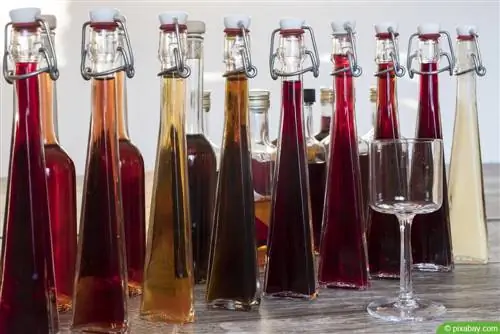
The recipe and manufacturing process of the legendary herbal liqueur have not changed since 1815. Although the exact ingredient composition is one of Italy's best-kept secrets, some of the 33 herbs and plants that provide the inimitable aroma have leaked out over a long period of time. These include star anise, gentian root, cardamom, angelica, cinchona, emperor root, rose petals, myrrh, rhubarb, vanilla, cinnamon and bitter and sweet orange peel. Supplemented with local herbs, high-proof alcohol and sugar, you can make your own personal Ramazotti. The following recipe may inspire you to create creative variations on the popular herbal schnapps:
Ingredients
- 1 star anise
- 1 tbsp dried rose petals
- 1 tsp dried sage
- 1 tsp dried rosemary
- 1 tsp dried peppermint
- 1 cinnamon stick
- 1 vanilla bean
- 2 cardamom pods
- 4 g gentian root (pharmacy)
- 1 Allspice Berry
- 700 ml grain or vodka
- 200 ml water
- 150 g agave syrup
Preparation
Coarsely crush the herbs and spices in a mortar. Place in a lockable container, e.g. E.g. a mason jar with a screw cap and pour alcohol over it. Close the container, shake and leave to stand at room temperature for 14 to 21 days. Shake or stir once a day. Then strain the mixture through a coffee filter, hair sieve or tea towel. Leave the herb and spice mix in the container. Mix filtered alcohol with agave syrup and water. Return to the container and allow to mature for another 6 to 8 weeks. Sift the herbal liqueur and pour it into a decorative bottle.
Practical basic equipment
So that making herbal liqueur is easy, simple basic equipment is valuable. Apart from the individual ingredients of your favorite recipe, we recommend the following working materials for preparation and storage:
- Sharp kitchen knife, peeler if necessary
- Mortar
- Fine sieve, hair strainer or filter bags
- Lockable, wide-necked container, e.g. E.g. screw-top jar or bowl with lid
- Glass bottles with screw caps for storage

